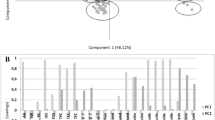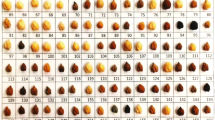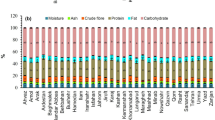Abstract
Chickpea is the world’s second most widely grown pulse. This legume will become increasingly important due to its natural drought and heat tolerance ability, and its capacity to fix atmospheric N2 in symbiosis with rhizobia what makes this pulse a low-water and carbon fingerprint crop. The aim of this study was to assess the nutritional value, the mineral composition, and the phenolic compound profiles of ten Spanish chickpea genotypes. Seed morphological characteristics were also determined as useful traits for analyzing plant biodiversity. Most of these advanced lines and/or recombinant inbred lines (RILs) were derived from intraspecific crosses among kabuli-type chickpeas genotypes. The variety Kasin and two RILs, namely 5-RIL-33 and 5-RIL-92, shared the same parental lines, one of them from India (WR315) of desi type. Only one genotype (5-RIL-33) has colored grains and pink flowers (common desi-type traits). These three genotypes were resistant to both ascochyta blight [Ascochyta rabiei (Pass.) Labr] and Fusarium oxysporum f. sp. ciceris race 5. The protein content of all genotypes was higher than 20% with some outstanding lines having > 25%. Other functional components such as crude fat, fiber, and carbohydrates contents and minerals were broadly uniform across the studied material. The analysis of the phenolic compounds on methanolic seed extracts reveals common features as the presence of gentisic and 4-hydroybezoic acids, besides l-glutamic, citric, and succinic organic acids. In contrast, some compounds such as gallic acid, gallocatechin, and rutin are exclusively present in the colored 5-RIL-33 line, in addition to the reference Apulian black chickpea variety.



Similar content being viewed by others
Data availability
The data generated and analyzed during the current study will be available from the corresponding author on reasonable request.
References
van der Maessen LJG (1972) Cicer L., a monograph of the genus, with special reference to the chickpea (Cicer arietinum L.), its ecology and cultivation. Landbouwhogeschool Wageningen. Veenman-341
Toker C (2009) A note on the evolution of kabuli chickpeas as shown by induced mutations in Cicer reticulatum Ladizinsky. Gen Resour Crop Evol 56:7–12
Eker T, Sari D, Sari H, Sule TH, Toker C (2022) A kabuli chickpea ideotype. Sci Rep. https://doi.org/10.1038/s41598-022-05559-3
Knights EJ, Wood JA, Harden S (2011) A gene influencing seed shape of desi type chickpea (Cicer arietinum L.). Plant Breed 130:278–280
Magrini MB, Anton M, Chardigny JM, Duc G, Duru M, Jeuffroy MH, Meynard JM, Micard V, Walrand S (2018) Pulses for sustainability: breaking agriculture and food sectors out of lock-in. Front Sustain Food Syst. https://doi.org/10.3389/fsufs.2018.00064
Oliveira B, de Moura AP, Cunha LM (2019) Increasing pulse consumption to improve human health and food security and to mitigate climate change. In: Castro P, Azul A, Leal Filho W, Azeiteiro U (eds) Climate change-resilient agriculture and agroforestry: ecosystem services and sustainability. Springer, London. https://doi.org/10.1007/978-3-319-75004-0_2
FAO/INFOODS (2017) Global food composition data base for pulses. User guide. https://www.fao.org/infoods/infoods/tables-and-databases/faoinfoods-databases. Accessed 15 Mar 2023
Margier M, Georgé S, Hafnaoui N, Remond D, Nowicki M, Du Chaffaut L, Amiot MJ, Reboul E (2018) Nutritional composition and bioactive content of legumes: characterization of pulses frequently consumed in France and effect of the cooking method. Nutrients. https://doi.org/10.3390/nu10111668
Vandemark GJ, Grusak MA, McGee RJ (2018) Mineral concentrations of chickpea and lentil cultivars and breeding lines grown in the US Pacific Northwest. Crop J. https://doi.org/10.1016/j.cj.2017.12.003
UPOV (International Union for the Protection of new varieties of Plants) (2020) Guidelines for the conduct of tests for distinctness, uniformity and stability. Code(s) CICER_ARI Cicer arietimum L.
Avola G, Patanè C, Barbagallo RN (2012) Effect of water cooking on proximate composition of grain in three Sicilian chickpeas (Cicer arietinum L.). Food Sci Technol 49:217–220
Dayrell RLC, Ott T, Horrocks T, Poschlod P (2023) Automated extraction of seed morphological traits from images. Methods Ecol Evol 14:1708–1718
Gil J, Castro P, Millán T, Madrid E, Rubio J (2017) Development of new kabuli large-seeded chickpea materials with resistance to Ascochyta blight. Crop Pasture Sci. https://doi.org/10.1071/CP17055
Caballo C, Madrid E, Gil J, Chen W, Rubio J, Millán T (2019) Saturation of genomic region implicated in resistance to Fusarium oxysporum f.sp. ciceris race 5 in chickpea. Mol Breed. https://doi.org/10.1007/s11032-019-0932-.4
Cervantes E, Martín JJ, Saadaou E (2016) Updated methods for seed shape analysis Hindawi Publishing Corporation Scientifica, pp 10. ID 5691825
Khamassi K, Babay E, Rouissi M, Dakhlaoui A, Rayda Ben Ayed R, Hanana M (2021) Genetic variability of tunisian faba beans (Vicia faba L.) based on seeds’ morphophysical properties as assessed by statistical analysis. Hindawi J Food Qual. https://doi.org/10.1155/2021/9493607
Daniel IO, Adeboye KA, Oduwaye OO, Porbeni J (2012) Digital seed morpho-metric characterization of tropical maize inbred lines for cultivar discrimination. Int J Plant Breed Genet 6:245–251
Gil J, Cubero JI (1993) Inheritance of seed coat thickness in chickpea (Cicer arietinum L.) and its evolutionary implications. Plant Breed 111:257–260
Moreiras O, Carbajal A, Cabrera L, Cuadrado C (2013) Tablas de composición de alimentos. Guía de Prácticas. Piramide, Madrid
Costantini M, Summo C, Centrone M, Rybicka I, Dagostino M, Annicchiarico P, Caponio F, Pavan S, Tamma G, Pasqualon A (2021) Macro- and micro-nutrient composition and antioxidant activity of chickpea and pea accessions. Polish J Food Nutr Sci. https://doi.org/10.31883/pjfns/135813
Polo Chávez IA (2012) Determinación proximal de los principales componentes nutricionales de seis variedades de leguminosas: arveja, garbanzo, haba, lenteja, maní y soya. Bachelor´s Degree. Pontificia Universidad Católica del Ecuador, Facultad de Ciencias Exactas y Naturales, Escuela de Ciencias Químicas
Khattak AB, Shah Khattak GS, Mahmood Z, Bibi N, Ihsanullah I (2006) Study of selected quality and agronomic characteristics and their interrelationship in kabuli-type chickpea genotypes (Cicer arietinum L.). Int J Food Sci Technol 41:1–5
Güzel D, Sayar S (2012) Effect of cooking methods on selected physicochemical and nutritional properties of barlotto bean, chickpea, faba bean, and white kidney bean. J Food Sci Technol 49:89–95
Lin P-Y, Lai H-M (2006) Bioactive compounds in legumes and their germinated products. J Agric Food Chem 54:3807–3814
Hoeck JA, Fehr WR, Murphy PA, Welk GA (2000) Influence of genotype and environment on isoflavone contents of soybean. Crop Sci 40:48–51
Segev A, Badani H, Kapulnik Y, Shomer I, Oren-Shamir M, Shmuel Galili S (2010) Determination of polyphenols, flavonoids, and antioxidant capacity in colored chickpea (Cicer arietinum L.). J Food Sci. https://doi.org/10.1111/j.1750-3841.2009.01477.x
Hungría M, Phillips DA (1993) Effects of a seed color mutation on Rhizobial nod-gene-inducing flavonoids and nodulation in common bean. MPMI 6:418–422
Puozaa DK, Jaiswal SK, Dakora FD (2021) Black seed-coat pigmentation is a marker for enhanced nodulation and N2 fixation in bambara groundnut (Vigna subterranea L. Verdc.) landraces. Front Agron 3:692238
Acknowledgements
The authors acknowledge Dr. Miguel Camacho for images-scanner acquisition and data management, and Laboratorio Agroalimentario de Córdoba (AGAPA-Andalucía) for proximate composition assessment. This work was supported by PRIMA PCI2020-112151 project.
Author information
Authors and Affiliations
Corresponding author
Ethics declarations
Conflict of interest
Authors declare that they do not have any financial and personal relationships with other people or organizations that could inappropriately influence (bias) their work. We have not used AI-assisted technologies in the writing process.
Compliance with ethics requirements
The article does not contain any studies with human or animal subjects.
Additional information
Publisher's Note
Springer Nature remains neutral with regard to jurisdictional claims in published maps and institutional affiliations.
Rights and permissions
Springer Nature or its licensor (e.g. a society or other partner) holds exclusive rights to this article under a publishing agreement with the author(s) or other rightsholder(s); author self-archiving of the accepted manuscript version of this article is solely governed by the terms of such publishing agreement and applicable law.
About this article
Cite this article
Brun, P., Camacho, M., Perea, F. et al. Characterization of Spanish chickpea genotypes (Cicer arietinum L.): proximate, mineral, and phenolic compounds composition. Eur Food Res Technol 250, 1007–1016 (2024). https://doi.org/10.1007/s00217-023-04437-0
Received:
Accepted:
Published:
Issue Date:
DOI: https://doi.org/10.1007/s00217-023-04437-0




